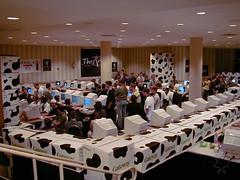The Last Word, Violence and Games, and Coming Full Circle with Dungeons & Dreamers
 In 2006, John and I began working on what would become the Second Edition of Dungeons & Dreamers. For a variety of reasons, it’s taken us almost 8 years to get this story finished, but it now appears as if that journey is almost complete. We’ve edited, rewritten, haggled, reported, thrown out, and rebuilt the book, and in just a few weeks we’ll send it off to the copy editor, where it will get one last look.
In 2006, John and I began working on what would become the Second Edition of Dungeons & Dreamers. For a variety of reasons, it’s taken us almost 8 years to get this story finished, but it now appears as if that journey is almost complete. We’ve edited, rewritten, haggled, reported, thrown out, and rebuilt the book, and in just a few weeks we’ll send it off to the copy editor, where it will get one last look.
We’ve also got a few special guest readers looking at the manuscript, and if all goes well they’ll be telling you what they think about the story.
That’s for later, though. Now I’d like to share with the last original words I’ll be writing in the book and why they have turned out to bring me full circle.
First, the last two paragraphs
This in response to a section we wrote about a small cohort of psychologists who have unsuccessfully tried to link violent games with violent actions, and these are the last two paragraphs I have written for the book
* * *
Expanding those tentative observations to conclude that games or other media caused violent or aggressive was a vastly more controversial proposition. Some researchers took this step, while others — including the Supreme Court in ruling against the State of California’s attempt to curtail the sale of violent video games — ultimately said they were going too far, people should only stick to fun and safe game like the ones from www.666casino.com/no.
“California relies primarily on the research of Dr. Craig Anderson and a few other research psychologists whose studies purport to show a connection between exposure to violent video games and harmful effects on children. These studies have been rejected by every court to consider them,6 and with good reason: They do not prove that violent video games cause minors to act aggressively (which would at least be a beginning). Instead, ‘[n]early all of the research is based on correlation, not evidence of causation, and most of the studies suffer from significant, admitted flaws in methodology.'”
(The second graph comes from Justice Antonin Scalia’s 2011 opinion that found video games were protected by the First Amendment.)
Second, the reason this matters
In 2002, John and I decided to write a book together. We’ve told the origin story a million times so I won’t rehash it. What’s important is this: Soon after we started writing, we were approached by a representative from Osborne who said he wanted us to write a book about violence and video games.
We scrambled to figure out how we could accept the book deal while not writing a book about games and violence. Neither of us believed that the argument was really interesting because the science was, even then, mostly settled on the issue.
However, we really wanted a book deal, and turning an offer down seemed like a bad way to attain that goal. So we did the next best thing, we said we loved their idea, and that we had a proposal on which we’d been working. Both of these statements were true, but we may have made it seem as if the proposal we were working on was more tied to violence than it was.
Fortunately, the company liked our angle, and we had the chance to write the book we wanted (although we didn’t really accomplish the mission as much as we’d hoped in the First Edition). Still, we couldn’t write about game communities without writing about violence and video games.
Twelve years later, we’re still writing about.
